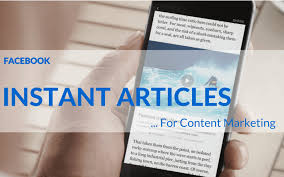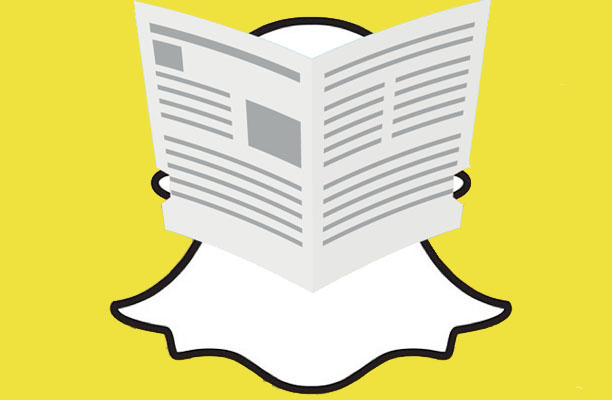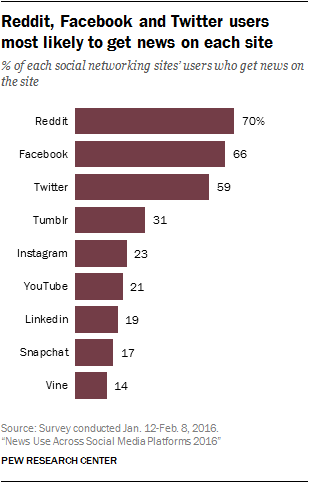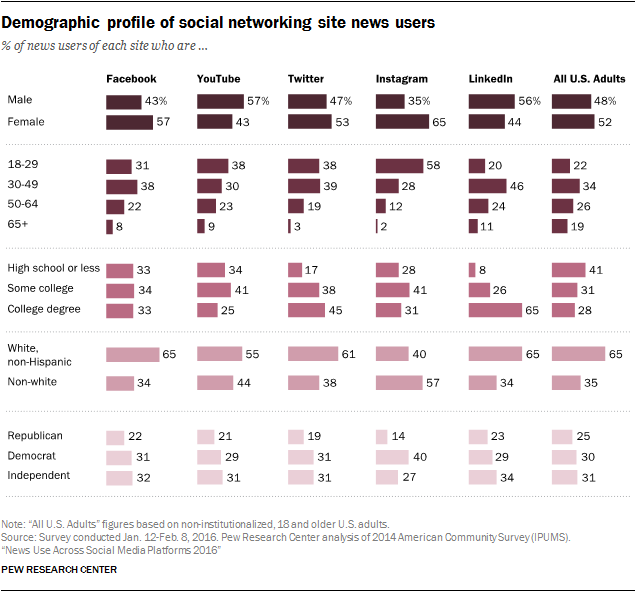Collaborate can not compete: social networks and news sites divide the audience

With the development of the Internet, anyone can become a journalist by talking about an event on a social network. Moreover, social networks have become one of the effective channels for disseminating information for advertisers, publications and news agencies.
The practice includes the cooperation of media companies with social networks. In this case, professional media intend to use social networks not only as an effective channel, but also as a means for monetization.
')
Would such cooperation be fruitful? What problems are already on the way to it? How profitable is the media, social networks and, most importantly, users?
Researchers from SocialFlow found that the metrics of media companies deteriorated due to the fault of the social network Facebook. Through the SocialFlow service, publishers post on Facebook and other social networks monthly up to half a million news items. Representatives of the service came to the conclusion that in May 2016, the number of readers of news items on Facebook decreased compared to January by 42%: from 117 thousand to 68 thousand.
The number of posts also decreased: from 42 billion in January to 37 billion in May. The fall is due to a change in Facebook algorithms. The social network constantly adjusts the display of posts, trying to improve the custom news feed.
Previously, one of the main factors in the publication of publications in the top was the interaction of users with content - what they like, comment, and what they share. However, this approach did not reflect the full picture and often impoverished the friendliness. To correct the situation, Facebook decided to listen to the opinion of the audience. More than a thousand users daily evaluated their experience and reported on how to improve the content - they made up the so-called Feed Quality Panel.
The social network also polled tens of thousands of users about how well the ranking works in their feed. Each publication was rated on a five-point scale - the more interesting the story, the more stars it received.
The study allowed the company to understand what content people would like to see in the top of the news feed, even if they did not interact with it. This information was used to improve the algorithms. Facebook now takes into account both signals - both specific actions and the possible attractiveness of the content. Innovations will not have a significant impact on the coverage or referral traffic of most communities, the developers promised. However, experiments negatively affect the content that media companies post.
The head of SocialFlow, Jim Anderson, believes that the social network has decided to increase the priority of personal stories of users, thereby encouraging the audience to actively share information.
The company is clearly concerned about the decline in the number of original records - in the first half of 2015, it decreased by 21%. People prefer to share news and information from other sites, and personal transfer to Snapchat , Instagram and other services. In addition, Facebook has set up algorithms so that there is no excess of news from one source in the feed. At the same time, the content began to move to the top. According to Anderson, even social network developers cannot evaluate the effect of algorithms.

Other changes
On June 2, Facebook representatives sent out messages to the users of the Notify application on discontinuing support for the application. Notify functionality is migrated to Facebook Messenger. The application has already been removed from the App Store.
Notify displayed the headlines of the most interesting user news, events and the like. The application was launched in November 2015, it was available for the iPhone and iPad.
At the end of May, it became known that Facebook's management made changes to the editing of the “hot topics” section, after the social network had been criticized for anti-conservative media policies.
"Our investigation did not show a systematic political bias in choosing news included in the section of topical issues ... Being committed to the principle of developing our products and minimizing the likelihood of human evaluation, we are conducting a number of changes in the section on topical issues," the news article said. the company.
At the same time, the investigation does not exclude cases of unintentional political bias in the selection of news, said Colin Stretch, the company's legal adviser.
The changes relate to the cancellation of the "top 10 approved sites" that the editors are targeting. As the Guardian newspaper noted earlier, these are such news providers as BBC News , CNN , Fox News , The Guardian , NBC News , The New York Times , USA Today , The Wall Street Journal , Washington Post , Yahoo News .
Instant Articles
On April 12, Facebook opened access to Instant Articles, “quick articles,” which can be read right inside the social network.
In the news feed on a smartphone, such articles are marked by lightning. “Instant Article” (Instant Article) is not a text that was transferred from one place to another, but a finished material with its own design: large photos, maps, video clips with autoplay, audio, comments and pictures that can be browsed by tilting the smartphone to the right and left.

The format works thanks to HTML5, adapted for smartphones and the slow Internet, - the data gets into the social network through an RSS feed. "Quick article" is associated with its address on the website of the publication. Therefore, if someone has posted a link to an article that has already been posted on Facebook, it will automatically be replaced with a “quick” one. For now, Instant Articles only works with publishing sites with its own content management systems, blogs and WordPress sites.
Readers Instant Articles will get the content faster. Facebook has calculated that an article in a mobile browser opens in eight seconds (according to 2014, 32% of sites required so much time). Articles in the social network are loaded 10 times faster, that is, they will open in 0.8 seconds. In addition, in a single mobile browser you cannot view a large photo by downloading the smartphone from side to side.
Editions will become even more dependent on Facebook. After the announcement of the “quick articles” The New York Times, NBC News and The Atlantic said that they were afraid of losing control over the distribution of content. In 2015–2016, the social network repeatedly changed the algorithm for issuing posts in the news feed. At first, priority was given to messages from friends, after a year they began to show media messages first.
The editors are going to use Instant Articles in different ways: The Economist planned to post four to five content on Facebook a day to draw attention to the paid version, and The Washington Post immediately launched the entire news feed on the social network on the day. Another incentive is a new advertising platform. Publications can advertise in articles and collect all the revenue themselves or use the Facebook advertising network.
In 2014, Facebook CEO Mark Zuckerberg said that his goal was “to create the perfect personalized newspaper for everyone.” When people can read the news inside Facebook, they will stop going to other sites. A social network will get more involvement, more advertising views and more data preferences of its users.
SocialFlow recommends publishers analyze their Facebook activity. If coverage starts to decline, you need to try different types of content and see which ones are most effective.
There is no universal solution; therefore, it is important to be alert and understand what led to the deterioration of performance - social network algorithms or own mistakes. Facebook’s work cannot but worry publishers, because social media is becoming the main source of news.
According to a similar scheme
What was described on the example of Facebook is gradually being adopted by other social networks.

Snapchat messenger launched the Discover section, in which news and entertainment content from media partners of the service will appear. This is reported in the official blog of the company. More than a dozen media companies, including CNN and ESPN, received a kind of “channels” on the service, where they can post 5-10 stories a day - articles, videos and other content. Publications are selected by editors of media resources and, according to Snapchat, will be organized in a logical order.
Following the Snapchat principle, stories are erased 24 hours after publication - “because today's news becomes history tomorrow,” say service representatives. Snapchat fame brought its distinguishing feature - self-destructing some time after the message was delivered to the addressee.
Financial terms of cooperation with the media are not disclosed. However, according to Reuters sources, full-screen video ads will appear in the stories from the publications, and media resources and Snapchat will share the proceeds from its sale.
The Discover function reflects Snapchat's desire to compete with Facebook and Twitter, which actively cooperate with media resources in placing content.
Not all social networks are equally useful.
 A public opinion poll for the first time showed that most Americans will get the latest news from social networks. According to a Pew Research Center study, 62% of respondents use Reddit, Facebook, and Twitter to get fresh information about the country and the world. In a similar survey conducted four years ago, this figure was 49%.
A public opinion poll for the first time showed that most Americans will get the latest news from social networks. According to a Pew Research Center study, 62% of respondents use Reddit, Facebook, and Twitter to get fresh information about the country and the world. In a similar survey conducted four years ago, this figure was 49%.In 18% of cases, social networks are often used as a news source, in 26% - from time to time, in 18% - very rarely. 38% of respondents never learn social media news. The most "loyal" readers are Reddit users - 70% of its audience is looking for news on the same site. For Facebook, the share of such users is 66%, for Twitter - 59%. Tumblr (31%), Instagram (23%) and YouTube (21%) have a smaller interest in the news.
Overall, however, Facebook is the leader. The social network covers 67% of the US adult population, so it is the source of news for 44% of Americans. For YouTube, this ratio is 48% to 10%, Twitter - 16% to 9%, Instagram - 19% to 4%.
For 64% of users who learn about news from social networks, a single site is enough. 26% prefer two sites, 10% for the news attend at least three social networks. Instagram, Facebook and YouTube audiences prefer to consume news in the background, along with other activities. Reddit, Twitter and LinkedIn users are more targeted.
The researchers also found that each of the five social networks is of interest to a particular demographic group. So, among LinkedIn users there are many (65%) college graduates, among the users of the Facebook network the majority are white non-Hispanic (65%) women (57%), and Instagram is popular with women (65%) and supporters of the democratic party (40%).

Monetization of the media in the new conditions
The era of the media as a commercial entity that generates revenue and pays dividends to shareholders is a thing of the past. Experts believe that the future belongs to non-commercial media that will operate on a completely new principle. Even global conglomerates, such as The Guardian, Mashable, Buzzfeed, had to think about revising their business models.
Columnist Michael Marinaccio argues about the causes of the plight of the media with traditional business models. He calls several factors: the destruction of the institute of print journalism, the rapid growth of Internet consumption to the detriment of television, the outflow of advertising budgets due to the fall in audience indicators, the success of small niche media.
His words confirm the data on global media consumption from ZenithOptimedia. According to the agency, in 2014–2017, the share of TV will decrease by 2.3 percentage points. newspapers - by 3.2 percentage points, magazines - by 1.5 percentage points Consumer attention will switch to mobile Internet, whose share will grow from 5.1% to 12.9%.

Renowned economist Julia Kazhe in the book “Saving the Media” writes: in order to survive, the media must turn to a non-profit news structure. Traditional media, aimed at making a profit, have already exhausted the possibilities of monetization and are now desperately looking for someone who is willing to pay.
A rich investor in this case is not a panacea, but a yoke: relying on one source of funding (for example, a big businessman), the media loses its independence. Big business takes advantage of the deplorable state of affairs in the media, and buys them entirely, which threatens their further work. A recent example is Amazon.com founder Jeff Bezos, who acquired the legendary Washington Post newspaper for a pittance - the amount of the transaction was only $ 250 million.
Source: https://habr.com/ru/post/302724/
All Articles